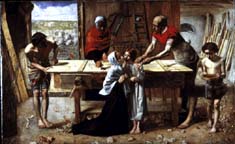 Sir John Everett Millais's Christ in the House of His Parents is precisely the sort of painting the Pre-Raphaelite Brotherhood loved to paint — and the sort of painting many critics at the time loved to hate.
The work, which portrays the Holy Family as ordinary people in a carpenter's shop, was inspired by a biblical quotation from Zachariah 13:6:
Sir John Everett Millais's Christ in the House of His Parents is precisely the sort of painting the Pre-Raphaelite Brotherhood loved to paint — and the sort of painting many critics at the time loved to hate.
The work, which portrays the Holy Family as ordinary people in a carpenter's shop, was inspired by a biblical quotation from Zachariah 13:6:
And one shall say unto him, What are these
Wounds in thy hands? Then he shall answer
Those with which I was wounded in the house of my friends.
When the painting was exhibited at the Royal Academy in 1850, critics brutally condemned Millais's unflattering representation of the Holy Family. They refused to refer to the painting by the title Millais had chosen, instead calling it merely The Carpenter's Shop.
Questions
1. In what ways did Millais deviate from the conventional painting techniques taught by the Royal Academy schools, and how does this divergence alter one's viewing experience? How does the composition of the painting direct a viewer's focus?
2. Charles Dickens attacked the figure of Christ as "a hideous, wry-necked, blubbering, red-headed boy, in a bed gown," and the figure of Mary as a "woman so hideous in her ugliness that É she would stand out from the rest of the company as a Monster, in the vilest cabaret in France, or the lowest gin shop in England." What might have been Millais's aim in depicting Christ and his mother as figures his viewers would find unattractive? Was Dickens's reaction even the intended response, or is there evidence in the painting that Millais was attempting to represent some sort of beauty?
3. How did Millais combine realistic elements and symbolic elements within the painting? What effect does this produce? For example, does the painting seem staged, or does it feel true to life?
4. In Millais's original drawing, the ladder and dove in the background are not present. What might be the significance of these additions in the final painting, and how vital are they to one's interpretation of the painting?
5. Each figure in the painting has a different facial expression. How do these inconsistent expressions affect the mood of the painting?
Bibliography
Millais, John Guile. The Life and Letters of John Everett Millais, President of the Royal Academy. 2 vols. New York: Frederick A. Stokes, 1899.
Last modified 5 October 2006